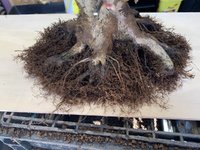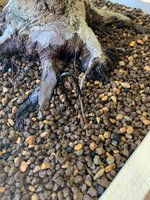Cadillactaste
Neagari Gal
Gorgeous tree...but that base! Hubba hubba...a big distraction for me personally. I absolutely love it.
Ryan Neil makes a comment about how you want to remove as much of a stub between buds as possible so they are not pushed laterally. I had often left a small bit behind assuming it didn't matter, but I am trying to be more precise now.Great job, it's developing nicely!
I wonder if @William N. Valavanis , David Easterbrook, or Suthin Sukolsovisit have found any tricks? They all have extraordinary Koto Hime specimens and severals decades of experience with Koto Hime.
During his first episode on the Asymmetry podcast Vojtilla mentioned that the orientation of buds transition from parallel to perpendicular in proportion with the length of the branches. From memory, I think he was talking about birch though. I have not investigated this idea yet, but planned to test it out this spring with Koto Hime and Shishigashira.
Maybe Kotohime behaves a bit differently, but I get wide angle branching on generic green a.p., Orange Dream, and generic green a. shirasawanum early season growth. Narrower angles result from May/Aug pruning. The existence of or the length of the stub has no bearing on it. It should also be noted that I'm talking about the growth from the most distal bud pair that is remaining.Ryan Neil makes a comment about how you want to remove as much of a stub between buds as possible so they are not pushed laterally. I had often left a small bit behind assuming it didn't matter, but I am trying to be more precise now.
The way I interpreted it was that if there was a stub then the new terminal buds would have that stub in the way and there would be a limit to how narrow an angle there could be. If you cut it very close, then there would be more space for the buds to be angled closer together.Maybe Kotohime behaves a bit differently, but I get wide angle branching on generic green a.p., Orange Dream, and generic green a. shirasawanum early season growth. Narrower angles result from May/Aug pruning. The existence of or the length of the stub has no bearing on it. It should also be noted that I'm talking about the growth from the most distal bud pair that is remaining.
It is fascinating to me how Ryan comes up with the most illogical stuff from time to time. There's a shoot of some thickness. It has opposite buds along its length. One cuts the stem above the node. How would the remaining node possibly grow to 'push the buds' apart?
I think there is an argument for rubbing off the buds if you want stronger growth from the remaining buds. If you wait till they leaf out and remove them, then you are weakening the tree. Weakening the growth might be more advantageous in another cultivar where you want shorter nodes, but for this one I want to push out extensions to build some length.Really nice tree. I've got a young koto hime that I'm still growing the trunk on. I'm wondering if it would be a good idea or not to rub some of the buds off of it. I'm also wondering how rubbing the buds off compares with cutting some of the basal leaves off in the spring (as you do earlier in the thread). Do they accomplish the same goals or slightly different?
This is what I understood it by as well. Which, if we simply remove all the bonsai knowledge, makes sense from a physics point of view, right? But good luck getting some scissors in to there to remove it... Maybe better off with a spike and kinda of stabbing the stub out of it.The way I interpreted it was that if there was a stub then the new terminal buds would have that stub in the way and there would be a limit to how narrow an angle there could be. If you cut it very close, then there would be more space for the buds to be angled closer together.









They are just standard japanese maple whips from Matt Ouwinga. The color is very similar and nothing that lime sulfur won't bleach. You shouldn't see much of them at all so there is no real concern.Great work, like where are going with this one.
Questions about the root grafting you are doing. Are the whips you used Koto Hime, or another cultivar? Bark color, shape looks like they may be standard Japanese maple? If so, what has your experience been? As likely to take? Final appearance of roots I imagine will resemble the mother tree? Or did you take cuttings from the mother tree earlier, and use them?
"there is a great disturbance in the force"They are just standard japanese maple whips. You shouldn't see much of them at all so there is no real concern.
